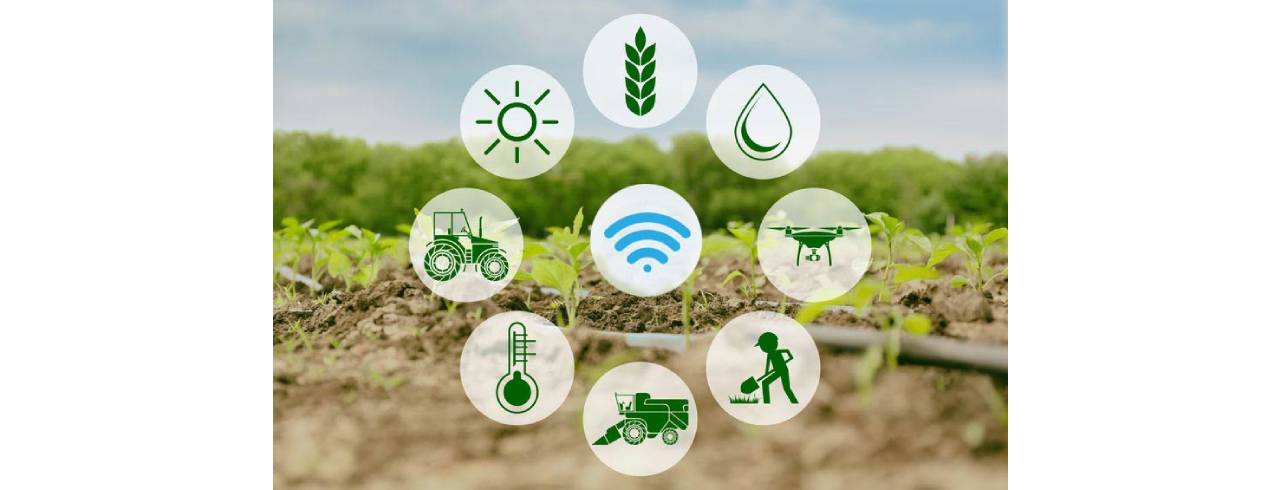In agriculture, contemporary technology can be used to its full potential, even though many people find farming to be outdated. Smart farming isn't just a sci-fi idea; it's an actual operational strategy that streamlines & automates the use of IoT in agriculture. But let's get down to business and talk about what's happening here.

When it comes to the concept of "smart farming" can be separated into two categories: smart agriculture & AgriTech.
· AgriTech is a piece of software designed to improve several aspects of smart agriculture iot.
· The term "smart agriculture" refers to the use of the Internet of Things and numerous attached devices to each other to improve agricultural practices.
Farmers can use each other to check anything from the cultivation of crops to the raising of livestock. It aids farmers in streamlining their operations and increasing the productivity of their farms.
Consider the essential advantages of smart agriculture using iot.
· Gathering information
Installed sensors can gather all of the necessary data—such as the current weather, the health of livestock and crops, etc. Farmers can review and evaluate their data because iot agriculture is all in one spot.
· Reductions in the dangers
When farmers have access to the most recent information, they can better foresee the future and anticipate potential issues. Using data to increase sales and adjust corporate operations can also benefit farmers.
· Making the business world automated
The efficiency of many corporate operations is increasing as more of them are automated. It is thus possible to devote oneself to more pressing matters.
· Higher standards of excellence
It is possible to minimize difficulties and eliminate all concerns that may develop throughout the farming process thanks to a smart agriculture system. So the condition of the work is improving, and buyers are getting a high-quality product at a reasonable price.
Now that we've outlined the primary benefits of IoT let's see how it's being used in smart agriculture using iot in more depth.
· Monitoring of livestock
Farmers may monitor the health of their cattle using sensors & wearable devices.
Farmers can keep an eye on their livestock, including cows, hens, goats, etc. Using this technology, farmers may better detect disease outbreaks and keep infected animals separate from the rest of their flock.
It is possible that farmers can save money by eliminating the need to send someone to check on the animals because they always know exactly what is going on with them.
An excellent example of this is the smart agriculture system using IoT, which uses collars to track cows' health, weather, & activity before sending the data to a central computer.
· Maintaining a close eye on the weather
A farmer might benefit from weather stations fitted with smart sensors that collect & transmit valuable data. As a result, the farmer receives pre-made analyses that allow him to make accurate forecasts and avert crop losses.
A smart agriculture system provides farmers with unique software and tools to monitor weather conditions.
· Automated greenhouses
It is possible to set up a system with many sensors in a greenhouse to monitor & automatically modify equipment that will provide the best possible conditions for every individual greenhouse.
In the case of the Growlink project, the utilization of artificial intelligence, computer vision, machine learning, plus sensor data is used to monitor & automate greenhouse crop conditions.
· Keeping tabs on your crops
Like sensors used for weather condition monitoring, crop monitoring sensors gather data on a variety of characteristics, including crop health, humidity, precipitation, and temperature.
Farmers can foresee and correct any deviations from the norm in advance. Sensors also aid farmers in determining when to plant and harvest crops.
As one of the most famous smart farming using IoT for crop monitoring, Semios gives growers the ability to monitor their crops from anywhere.
· Agronomic systems for smart agriculture using iot
An effective system is needed to gather and organize all of the data. For example, farmers must have a system that provides reporting, monitoring, & accounting tools.
Everything you need to analyze your farm's current state, manage your business processes, and generate reports is included in FarmLogs.
· Using Drones
With the ability to spray pesticides or send videos to farmers in real-time, drones might be a valuable tool in agriculture.
Example of Bluetooth 5.0/5.1 low energy module by BLE module -
It uses a Nordic nRF52840/nRF52833 SoC with an efficient & comprehensive radio design on the PCB antenna to provide a sophisticated, ultra-compact, extremely flexible, & ultra-low-power wireless 5.0/5.1 Module. For nRF52840/nRF52833 hardware, MS88SF3 provides USB access, up to 8 dBm transmission power, up to 5.5V supply requirements, 802.15.4 (Thread/Zigbee) implementations, Bluetooth 5 Long Range Feature, and additional security features.
What are the ways of power equipment?
A power source is required for smart agriculture iot hardware located a long distance away from your home or office. As a result, you'll need to consider how you'll power this equipment. As a result, whether or not to use solar panels or large batteries depends on the user's unique needs.
How does the Internet of Things help with the frequency of data collection?
Identify the frequency with which you require new information. It's doubtful that you'll need to monitor your livestock's health constantly, so be sure to adapt your monitoring accordingly.
When it comes to agriculture, what is the role of IoT?
Before starting a smart agriculture system using iot, it's essential to figure out why you need it and what metrics you need to track. To make an informed choice about IoT hardware and software, you'll have to do your homework. For example, a specific IoT device is required to keep tabs on animals, whereas crop health requires a different type of device.